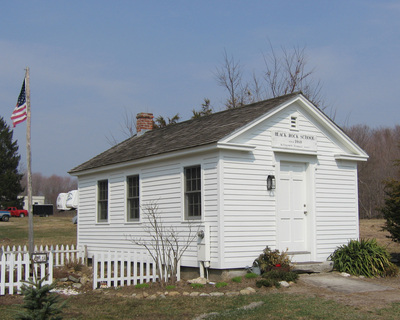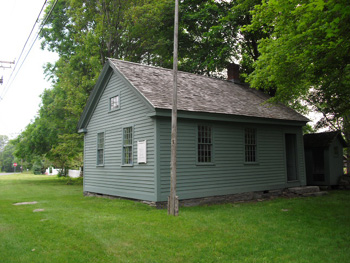The History of
|
The History of the
|
|
Killingworth originally comprised present day Killingworth and the Town of Clinton to the south. Killingworth was first settled in 1663 as the plantation of “Homonoscitt” (Hammonasset). Among the regulations for the ordering of the plantation in October 1663 was that there shall be at least thirty families on the east side of the Hammonasset. The 30 lots were laid out along what is Main Street in Clinton on both sides of the Indian River. Then, at a Court of Election held in Hartford on May 9, 1667, it was ordered that “ye towne of Homonoscit shal for ye future be named Kenilworth.” This date is traditionally used for the founding of Killingworth. On October 10, 1667, the Court gave permission for the inhabitants of Kenilworth “to gather themselves into church order.” In October 1667, a call to be minister was made to the Rev. John Woodbridge, a graduate of Harvard College. He was pastor until 1679 when he resigned and became pastor in Wethersfield. Through corruption of spelling, Kenilworth gradually became Killingworth, which was used exclusively after 1707. CLICK FOR MORE...
|
The Town of Killingworth purchased the 131-acre property now known as the Parmelee Farm in 2000. The property has become a community center with Community Gardens, hiking trails, and a place for many types of events. The house and garage have been leased to the Killingworth Historical Society, which is responsible for its maintenance and all utilities.
The farmhouse (above) has been placed on the State Register of Historic Places. It is a rectangular (35’ x 25’), two-story timber-framed building oriented with a five-bay façade to the west and its gable ends to the north and south. At the building’s south gable end is a small, one-story peak-roofed kitchen wing (16’ x 16’). Architecturally, the house is a center chimney type with Federal and Greek Revival characteristics. There are three fireplaces in the main house and a cooking fireplace and bake oven in the kitchen. A Colonial road passes by just east of the house. CLICK FOR MORE... |
Oral & Written History Project: Your Story is Our Story

The Killingworth Historical Society is collecting stories about life in our town. Tell your story in writing or in a recording through our Oral History Project.
History isn't just the distant past, it's our past, your past, and our present. Anyone of any age can offer a glimpse of life in Killingworth so future generations will know what it was like when you lived here. Share your recollections of the Killingworth you know:
To share your story, contact us:
by mail
Killingworth Historical Society
PO Box 707
Killingworth, CT 06419
by email
[email protected]
or get in touch with a KHS Board Member.
History isn't just the distant past, it's our past, your past, and our present. Anyone of any age can offer a glimpse of life in Killingworth so future generations will know what it was like when you lived here. Share your recollections of the Killingworth you know:
- The people - your family, friends, teachers, neighbors...
- The places - homes, schools, churches, businesses, ball fields, Chatfield Hollow, Cowboy Valley...
- The events - school events, town picnics, Killingworth Follies, parades, fairs...
- The groups - fire department, church communities, garden club, scouts, sports teams...
- Everyday life - what's your life like in Killingworth?...
To share your story, contact us:
by mail
Killingworth Historical Society
PO Box 707
Killingworth, CT 06419
by email
[email protected]
or get in touch with a KHS Board Member.
Killingworth Town Hearse, circa 1860
 Listing from MIddletown, Conn., City Directory, 1875-76.
Listing from MIddletown, Conn., City Directory, 1875-76.
Killingworth's town hearse was purchased in 1871 after a resolution at a Board of Selectmen's meeting that "the public convenience and wants require that the town provide a hearse for burial of the dead." Henry Kelsey and Nathan Lane were appointed the town's agents and given a budget of $500 to secure the needed carriage. A used hearse was purchased in Middletown for $150. Once procured, Orlando E. Redfield was placed in charge of the horse-drawn vehicle.
In the 1970s, after spending many inactive years in a shed behind the old town hall, the hearse was donated to the Killingworth Historical Society. Over the next 30 years, she was taken out on a few occasions and some minor restoration work was done. Finally on a cold day in early 2003, the hearse was loaded onto a flatbed trailer and brought to Mary Lightner in Bernardston, Massachusetts. Mary spent almost 2 1/2 years restoring the hearse she christened "Harriet" bringing her back to original beauty.
The original carriage makers' tag was uncovered during the restoration showing it had been built by Cornwell & Warner carriage makers of Middletown, Connecticut. The company was in business in the mid-19th century. By her simple design, it is estimated the hearse was probably built around 1860 as post-Civil War hearses were much more ornate, crowned with decorative carvings and ornate lamps.
In the 1970s, after spending many inactive years in a shed behind the old town hall, the hearse was donated to the Killingworth Historical Society. Over the next 30 years, she was taken out on a few occasions and some minor restoration work was done. Finally on a cold day in early 2003, the hearse was loaded onto a flatbed trailer and brought to Mary Lightner in Bernardston, Massachusetts. Mary spent almost 2 1/2 years restoring the hearse she christened "Harriet" bringing her back to original beauty.
The original carriage makers' tag was uncovered during the restoration showing it had been built by Cornwell & Warner carriage makers of Middletown, Connecticut. The company was in business in the mid-19th century. By her simple design, it is estimated the hearse was probably built around 1860 as post-Civil War hearses were much more ornate, crowned with decorative carvings and ornate lamps.
Artifacts & Properties
Click photos for larger image and description.
Stepping Back in Time as We Visit a Killingworth One Room Schoolhouse
Have you ever wondered what is was like to be a student in the 19th and early 20th centuries and attend a one-room schoolhouse? Well, this October the Killingworth Historical Society is transporting our KES 3rd graders back in time to experience being educated in a one-room schoolhouse.
As part of our Education Outreach Program, we will be opening the doors of The Pine Orchard School House, which now sits nestled in a field at Parmelee Farm. Once inside our students will learn about our town’s history and learn lessons on a slate board.
Students learned reading, writing and arithmetic, surrounded by grades one through eight, all taught by one teacher. During recess our students might play a game of marbles or master the art of hoops and sticks.
Our students will have the unique opportunity to immerse themselves in the experience of learning about our town’s history and what a typical day in the life of a student in Killingworth was like over one hundred years ago.
Please be sure to check back with us, as we get closer to October 2023. We will have many more details about this exciting venture! We will even include some snippets of history and stories about our town’s treasured one-room schoolhouses.
As part of our Education Outreach Program, we will be opening the doors of The Pine Orchard School House, which now sits nestled in a field at Parmelee Farm. Once inside our students will learn about our town’s history and learn lessons on a slate board.
Students learned reading, writing and arithmetic, surrounded by grades one through eight, all taught by one teacher. During recess our students might play a game of marbles or master the art of hoops and sticks.
Our students will have the unique opportunity to immerse themselves in the experience of learning about our town’s history and what a typical day in the life of a student in Killingworth was like over one hundred years ago.
Please be sure to check back with us, as we get closer to October 2023. We will have many more details about this exciting venture! We will even include some snippets of history and stories about our town’s treasured one-room schoolhouses.

















